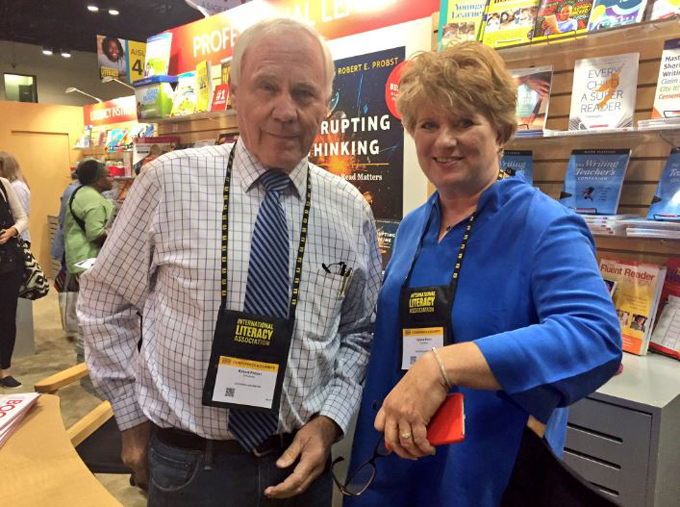 If anyone knows how to engage readers, it’s literacy experts and authors Kylene Beers and Bob Probst. Their latest book, Disrupting Thinking: Why How We Read Matters (Scholastic), is lauded not only for its techniques and strategies, but also for its humor and accessibility—no small feat for a professional development text. In fact, the book was such a hit at the ILA 2017 Conference & Exhibits that Scholastic sold out of copies halfway through day two. Thankfully, Beers and Probst will return to the stage at the ILA 2018 Conference as featured speakers to talk about why reading is our most important skill in the 21st century.
If anyone knows how to engage readers, it’s literacy experts and authors Kylene Beers and Bob Probst. Their latest book, Disrupting Thinking: Why How We Read Matters (Scholastic), is lauded not only for its techniques and strategies, but also for its humor and accessibility—no small feat for a professional development text. In fact, the book was such a hit at the ILA 2017 Conference & Exhibits that Scholastic sold out of copies halfway through day two. Thankfully, Beers and Probst will return to the stage at the ILA 2018 Conference as featured speakers to talk about why reading is our most important skill in the 21st century.
If you missed their session at ILA 2017 or simply need a refresher, here are seven quotes from Beers and Probst that made us stop, reflect, and think about reading in new ways.
1. Reading should be transformational
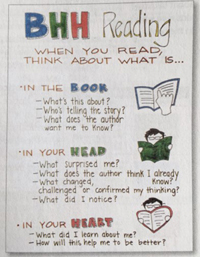 Beers and Probst believe that, “If the reader isn’t responsive, if she doesn’t let the text awaken emotion or inspire thoughts, then she can barely be said to be reading at all.” Their Book, Head, Heart (BHH) framework alerts readers to pay attention to the text, their thoughts about it, what they feel, and how they might have changed by reading it.
Beers and Probst believe that, “If the reader isn’t responsive, if she doesn’t let the text awaken emotion or inspire thoughts, then she can barely be said to be reading at all.” Their Book, Head, Heart (BHH) framework alerts readers to pay attention to the text, their thoughts about it, what they feel, and how they might have changed by reading it.
2. Give choice with direction
Beers and Probst acknowledge that, for students who do not see themselves as readers, personal choice may be overwhelming.
“Giving kids choice doesn’t mean that you just sit back and say, ‘Go pick a book.’ Giving kids choice means showing them what’s out there that they might really enjoy. So, what we would encourage you to do is to say ‘What is the structure I’ve set up in my classroom that helps kids make an informed choice? Am I providing book talks? Do I have a limited number of books on the chalkboard ledge? Do I have titles up in the room for kids to look at?’” says Beers. “I want to give kids choice, but I want to give that within limits, because when I’m learning about books and genre and topics, limits help me.”
3. Focused silent reading is key
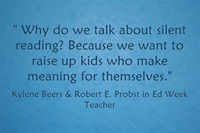 In an interview with Education Week, Beers and Probst note that today’s students live in a time when “information and entertainment can come to us in ways that don't require we read.” Those who rely on “political pundits, television commentators, flashy salesmen, unscrupulous preachers, or corner-hawkers” relinquish control of meaning-making. Silent, independent reading invites self-reflection and unguided interpretation—providing the reader with full ownership over his or her response to the text.
In an interview with Education Week, Beers and Probst note that today’s students live in a time when “information and entertainment can come to us in ways that don't require we read.” Those who rely on “political pundits, television commentators, flashy salesmen, unscrupulous preachers, or corner-hawkers” relinquish control of meaning-making. Silent, independent reading invites self-reflection and unguided interpretation—providing the reader with full ownership over his or her response to the text.
4. Relevance reigns
The authors maintain that getting kids’ attention is about interest—but sustaining it is about relevance. Instead of striving to satisfy interest, which is often fleeting, Beers and Probst encourage educators to introduce texts using strategies that increase engagement and point out relevance, which is always personal. “When they discover the relevance, their energy for and attention to the task will soar,” the authors write in Disrupting Thinking.
5. Competence starts with confidence
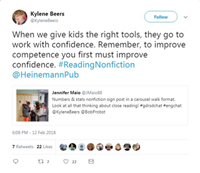 In a video produced by Scholastic, Beers says, about disenfranchised readers, “If you want to improve his skills, or her skills, what you have to do is start by building that child’s confidence.” The authors maintain that the interdependence between skill and will is research-based.
In a video produced by Scholastic, Beers says, about disenfranchised readers, “If you want to improve his skills, or her skills, what you have to do is start by building that child’s confidence.” The authors maintain that the interdependence between skill and will is research-based.
6. Create understanding—don’t check for it
Research shows that most classroom conversations stem from monologic questions—those for which the teacher already has an answer. Beers and Probst encourage teachers and parents to instead talk with students about what they don’t understand, through dialogic questions that develop thinking. Compared with monologic questions, dialogic questions are viewed by children as "authentic" problem-solving opportunities, resulting in higher engagement; increased student-to-student interaction; more frequent use of complete sentences; stronger inferences; and improved test scores.
7. Nonfiction ≠ not false and not false ≠ not true
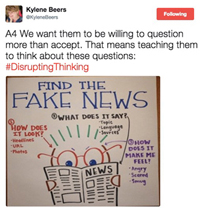 Many children—and adults—believe that if fiction is invented and imaginary, nonfiction must be real and true. Beers and Probst dispel this notion, asserting that, “nonfiction is that body of work that offers us information—and we have a job to decide if it is or is not true in our world.” The authors urge educators to present nonfiction as an exercise in critical thinking—an opportunity to assess the quality of statements offered, ask questions, and challenge preexisting beliefs.
Many children—and adults—believe that if fiction is invented and imaginary, nonfiction must be real and true. Beers and Probst dispel this notion, asserting that, “nonfiction is that body of work that offers us information—and we have a job to decide if it is or is not true in our world.” The authors urge educators to present nonfiction as an exercise in critical thinking—an opportunity to assess the quality of statements offered, ask questions, and challenge preexisting beliefs.
For more insights, visit Scholastic’s “Ten Tips with Kylene Beers & Robert E. Probst” YouTube series. Happy disrupting!
Kylene Beers and Bob Probst will present a session titled “Revising Reading” on July 22 during the ILA 2018 Conference in Austin, TX. For more information, visit ilaconference.org.
Alina O’Donnell is the communications strategist at ILA and the editor of Literacy Daily.